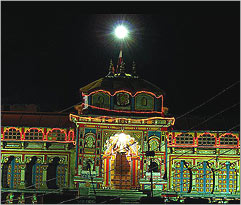Why did we choose to work in Uttarakhand ?
Char Dham Yatra
Badrinath
Badrinath was established as a major pilgrimage site by Adi Shankara in the ninth century. In recent years its popularity has increased significantly, with an estimated 600,000 pilgrims visiting during the 2006 season,compared to 90,676 in 1961. The temple in Badrinath is also a sacred pilgrimage site for Vaishnavites.
Badrinath has been mentioned as a holy place in scriptures and legends for thousands of years. According to the Bhagavata Purana, "There in Badrikashram the Personality of Godhead (Vishnu), in his incarnation as the sages Nara and Narayana, had been undergoing great penance since time immemorial for the welfare of all living entities." (Bhagavata Purana 3.4.22)

Badri refers to a berry that was said to grow abundantly in the area, and nath means "Lord of". Badri is also the Sanskrit name for the Indian Jujube tree[4], which has an edible berry. Some scriptural references refer to Jujube trees being abundant in Badrinath.
The Badrinath temple is the main attraction in the town. According to legend Shankara discovered a black stone image of Lord Badrinarayan made of Saligram stone in the Alaknanda River. He originally enshrined it in a cave near the Tapt Kund hot springs.In the sixteenth century, the King of Garhwal moved the murti to the present temple. .
The temple has undergone several major renovations because of age and damage by avalanche.In the 17th century, the temple was expanded by the kings of Garhwal. After significant damage in the great 1803 Himalayan earthquake, it was rebuilt by the King of Jaipur. .
The temple is approximately 50 ft (15 m) tall with a small cupola on top, covered with a gold gilt roof.The facade is built of stone, with arched windows. A broad stairway leads up to a tall arched gateway, which is the main entrance. The architecture resembles a Buddhist vihara (temple), with the brightly painted facade also more typical of Buddhist temples.Just inside is the mandapa, a large pillared hall that leads to the garbha grha, or main shrine area. The walls and pillars of the mandapa are covered with intricate carvings..
The Badrinath area is referred to as Badari or Badarikaashram in Hindu scriptures. It is a place sacred to Vishnu, particularly in Vishnu's dual form of Nara-Narayana. Thus, in the Mahabharata, Siva, addressing Arjuna, says, "Thou wast Nara in a former body, and, with Narayana for thy companion, didst perform dreadful austerity at Badari for many myriads of years." .
One legend has it that when the goddess Ganga was requested to descend to earth to help suffering humanity, the earth was unable to withstand the force of her descent. Therefore the mighty Ganga was split into twelve holy channels, with Alaknanda one of them. .
The mountains around Badrinath are mentioned in the Mahabharata, when the Pandavas are said to have ended their life by ascending the slopes of a peak in western Garhwal called Swargarohini - literally, the 'Ascent to Heaven'. Local legend has it that the Pandavas passed through Badrinath and the town of Mana, 4 km north of Badrinath, on their way to Svarga (heaven). There is also a cave in Mana where Vyasa, according to legend, wrote the Mahabharata.